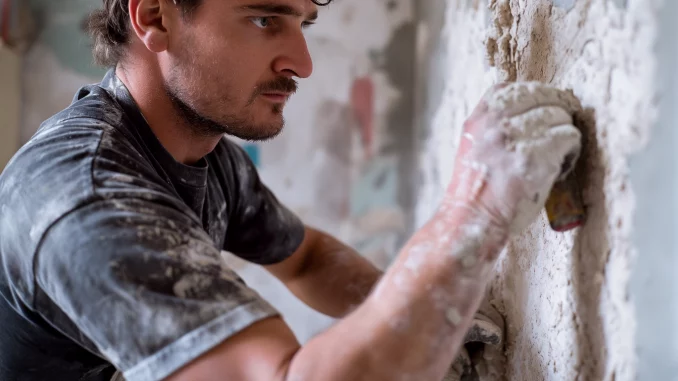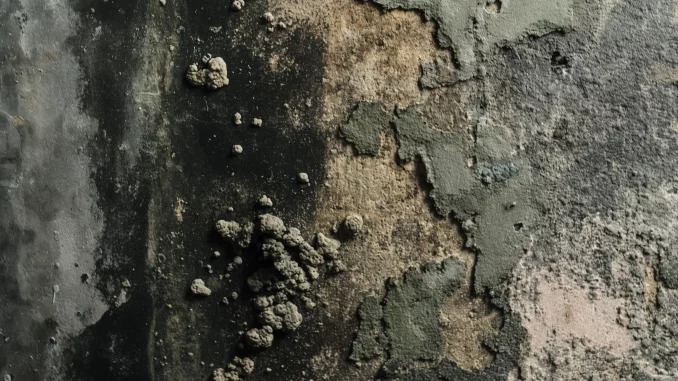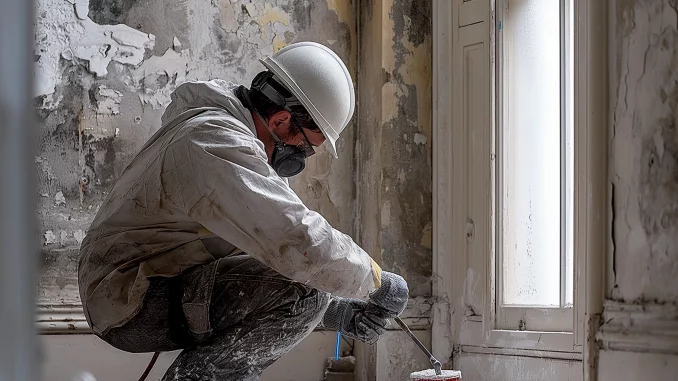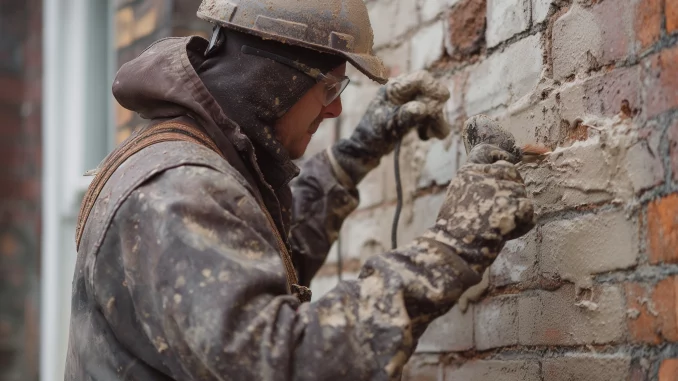
Dampness in homes is more than a mere inconvenience; it’s a pervasive issue that affects not only the structural integrity of properties but also the health and financial well-being of homeowners. In regions like London, where the climate can exacerbate the problem, understanding, preventing, and treating dampness is crucial. This comprehensive guide aims to equip homeowners with the knowledge to tackle damp issues effectively without breaking the bank.
Damp Overview
At its core, unwanted moisture within the home environment can lead to several structural and health issues. Typically, this is identified by a musty smell, the presence of mould, and unsightly stains on walls. The types of damp can be broadly categorised into rising damp, penetrating damp, and condensation, each with unique causes and effects on a building.
Rising damp occurs when ground water moves up through walls, floors, and masonry. Penetrating damp is usually the result of water infiltrating from the outside due to structural problems, such as roof damage or faulty guttering. Condensation, the most common form, arises from high humidity levels inside the home that condense on cooler surfaces, leading to mold growth.
Understanding these types of damp is the first step in addressing the problem. However, accurate identification and diagnosis are paramount. Mistaking condensation for rising damp, for example, could lead to unnecessary and expensive treatments that don’t solve the underlying issue.
Causes and Identification

The sources of moisture that lead to dampness can be as varied as the types of damp themselves. External leaks from damaged roofs or plumbing, internal condensation produced by daily activities such as cooking and showering, and groundwater are all potential culprits. Identifying the source requires a keen eye for signs of dampness and, often, a professional assessment.
Rising damp has distinct indicators, such as a ‘tide line’ of staining or salt deposits on walls. It’s crucial, however, to have these signs professionally confirmed to avoid misdiagnosis. Similarly, the identification of penetrating damp involves looking for external defects that could allow water ingress, while signs of condensation include water droplets on windows and walls, peeling wallpaper, and mould growth.
Given the complexity of accurately diagnosing damp, a professional assessment is often key. Specialists can employ a range of tools and techniques, from moisture meters to thermal imaging, to pinpoint the exact cause and extent of the problem. This step is crucial not only for ensuring that the treatment is appropriate but also for planning preventive measures to avoid recurrence.
Prevention and Maintenance
Preventing damp is invariably more cost-effective and less disruptive than curing it. Simple strategies can significantly reduce the risk of damp problems developing. Improving ventilation, particularly in high-moisture areas like kitchens and bathrooms, is essential. This can involve the installation of vents or extractor fans and regular opening of windows to allow airflow. Waterproofing measures, such as applying water-repellent coatings to external walls and ensuring that basements are properly sealed, can prevent penetrating damp. Drainage improvements around the property can also protect against rising damp by preventing water from pooling against walls.
Maintenance plays a crucial role in damp prevention. Regular inspections of the property can identify potential issues before they escalate. Key tasks include clearing gutters of debris, checking for and sealing leaks, and ensuring that the exterior of the property is in good repair to prevent water ingress.
The importance of these preventive measures cannot be overstated. They not only protect the structural integrity of the home and maintain healthy living conditions but also prevent the financial strain associated with major damp treatments. Early intervention can save homeowners significant costs in the long run, highlighting the adage that prevention is better than cure.
Solutions and Treatment Options

When damp issues do arise, the choice of treatment depends on the type and severity of the damp, as well as the homeowner’s budget. For mild issues, such as minor condensation, DIY solutions like the use of dehumidifiers and simple waterproofing measures can be effective. However, severe problems like rising or penetrating damp may require professional solutions, including damp-proof courses (DPC), chemical injections, and physical barriers.
Damp-proof courses (DPC), chemical injections, and physical barriers are among the professional treatments available. DPC involves creating a barrier through the lower sections of walls to prevent moisture from rising. Chemical injections, where a water-repellent chemical is injected into the walls, can also stop rising damp. For penetrating damp, repairs might include fixing the root cause of water ingress, such as roof repairs or replacing faulty guttering.
The cost of treating damp varies widely, depending on the size of the property, the extent of the damage, and the chosen treatment method. Prices can range from a few hundred pounds for minor interventions to several thousand for comprehensive damp-proofing services that might include waterproofing, fungi treatment, and structural repairs.
Choosing between DIY and professional treatments involves a cost-benefit analysis. While DIY can be cost-effective for minor issues, professional treatment is often necessary for severe cases to ensure the problem is fully addressed. This choice is crucial not only for the effectiveness of the treatment but also for its longevity, potentially saving homeowners from future expenses.
Health and Structural Impacts
The consequences of untreated damp extend beyond the immediate annoyance and aesthetic concerns. Health implications are significant, with damp environments fostering the growth of mold and mildew, which can lead to respiratory issues, allergies, and other health problems. Particularly for individuals with pre-existing conditions like asthma, the presence of mould spores can exacerbate symptoms, highlighting the importance of maintaining a dry and healthy living environment.
Structurally, damp can be devastating. Over time, moisture can weaken building materials, leading to decay in wooden elements like joists and skirting boards, and in severe cases, compromise the building’s structural integrity. The aesthetic impact is equally problematic, with damaged plaster, peeling paint, and stains often necessitating extensive repairs. Addressing these issues not only requires significant financial investment but can also disrupt daily life, making early detection and treatment of damp crucial.
Cost-Benefit and Professional Involvement

When facing damp issues, homeowners must weigh the cost and benefits of DIY versus professional intervention. While DIY solutions may offer a temporary fix at a lower cost, they might not address the root cause of the problem, leading to recurrent issues and potentially higher costs in the long run. In contrast, professional services, although initially more expensive, provide a comprehensive approach that ensures the problem is thoroughly addressed.
Selecting the right professional, such as those found through TrustATrader, is critical for effective resolution. Homeowners should seek out reliable and experienced damp-proofing specialists, ensuring they have the necessary qualifications and positive customer reviews. This vetting process is essential for severe cases of damp, where accurate diagnosis and treatment are crucial for effective resolution. Additionally, professionals can provide accurate cost estimations, helping homeowners budget for the necessary work.
The decision to opt for professional services should also consider the long-term savings and benefits. Effective damp treatment can enhance a property’s structural integrity, improve health outcomes for residents, and even increase the property’s value. Given these advantages, investing in professional damp-proofing services can be cost-efficient, offering peace of mind and long-term financial savings.
“Hiring professional damp specialists represents a wise investment in the long-term health and structural integrity of your property. While upfront costs may seem higher, the accuracy in diagnosis and treatment specificity can prevent recurrent issues, saving homeowners thousands in potential repairs. It’s not just about solving the problem today; it’s about safeguarding your home for tomorrow, ensuring durability and maintaining property value without unnecessary expenditures over time.”- Phil Donno – London Damp Treatments.
Environmental and Economic Considerations
In today’s climate-aware society, the environmental impact of home maintenance and improvement projects is a growing concern. Damp-proofing is no exception, and there’s a growing trend towards using eco-friendly materials and methods in addressing damp issues. These practices not only mitigate the environmental footprint but can also offer health benefits by reducing exposure to harmful chemicals.
Homeowners are encouraged to consider energy-efficient solutions as part of their damp-proofing strategy. For example, improved insulation and ventilation not only help control damp and condensation but can also reduce heating costs, contributing to a more sustainable and economically efficient home.
A comprehensive approach to damp-proofing that considers environmental impact, health, structural integrity, and economic factors can significantly benefit homeowners. By addressing damp issues promptly and effectively, homeowners can protect their investments, enhance their living conditions, and contribute to a healthier environment.
Final Thoughts
Tackling damp in the home requires a multifaceted approach that balances immediate needs with long-term considerations. From understanding the types and causes of damp to choosing between DIY and professional solutions, homeowners must navigate a complex landscape. Yet, with the right knowledge and actions, it’s possible to save both your home and wallet from the perils of damp. As we continue to explore the nuances of budget damp-proofing, the importance of informed decision-making and proactive measures becomes increasingly clear, ensuring that homes remain safe, healthy, and structurally sound for years to come.